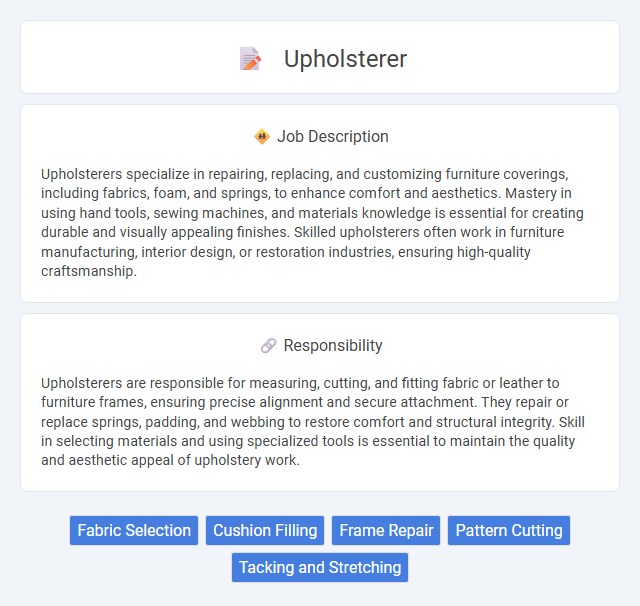
Upholsterers specialize in repairing, replacing, and customizing furniture coverings, including fabrics, foam, and springs, to enhance comfort and aesthetics. Mastery in using hand tools, sewing machines, and materials knowledge is essential for creating durable and visually appealing finishes. Skilled upholsterers often work in furniture manufacturing, interior design, or restoration industries, ensuring high-quality craftsmanship.
Individuals with strong manual dexterity and a keen eye for detail are likely suitable for an upholsterer job, as precise craftsmanship is required. Those who can tolerate physical labor and prolonged periods of standing may have a higher probability of thriving in this role. People with limited patience or difficulty handling repetitive tasks might find this job challenging.
Qualification
Upholsterers require proficiency in fabric cutting, sewing, and padding techniques to restore or create furniture coverings. Mastery in using hand and power tools, combined with knowledge of materials such as foam, springs, and webbing, is essential for precision and durability. Completing vocational training or apprenticeships enhances practical skills and ensures adherence to safety standards in upholstery craftsmanship.
Responsibility
Upholsterers are responsible for measuring, cutting, and fitting fabric or leather to furniture frames, ensuring precise alignment and secure attachment. They repair or replace springs, padding, and webbing to restore comfort and structural integrity. Skill in selecting materials and using specialized tools is essential to maintain the quality and aesthetic appeal of upholstery work.
Benefit
Upholsterer jobs likely offer benefits such as job stability and opportunities for creative expression in furniture restoration and custom design. Workers may gain specialized skills that increase employability across industries like interior design and automotive refurbishment. Health benefits and potential for self-employment could also be common advantages in this field.
Challenge
The upholsterer job likely involves the challenge of working with diverse materials and complex patterns to restore or create furniture that meets client expectations. Precision and attention to detail probably play a critical role in achieving seamless finishes and durable results. Problem-solving skills may be necessary to address unexpected issues such as material shortages or structural repairs during projects.
Career Advancement
Upholsterers with advanced skills in furniture restoration and custom design often progress to supervisory roles or open specialized workshops, enhancing their career trajectory. Mastery in modern materials and CAD software contributes to opportunities in high-end commercial and residential projects. Networking with interior designers and manufacturers further accelerates professional growth and income potential.
Key Terms
Fabric Selection
Upholsterers specialize in fabric selection to enhance both the durability and aesthetic appeal of furniture pieces, choosing materials such as leather, cotton, linen, and synthetic blends based on the client's needs and the item's usage. They assess fabric qualities including texture, colorfastness, pattern alignment, and abrasion resistance to ensure optimal performance and longevity. Expertise in fabric selection requires knowledge of industry trends, upholstery techniques, and compatibility with padding and frame structures for seamless integration.
Cushion Filling
Upholsterers specializing in cushion filling expertly select and insert materials such as foam, feathers, and synthetic fibers to achieve optimal comfort and durability. Mastery in measuring and cutting cushion fillings ensures precise fit and enhanced aesthetic appeal for sofas, chairs, and other upholstered furniture. Their skill directly impacts the longevity and support quality of cushions, crucial for customer satisfaction and furniture performance.
Frame Repair
Upholsterers specializing in frame repair expertly restore wooden furniture structures to ensure durability and stability. They utilize tools such as clamps, hammers, and wood glue to fix broken or weakened frame joints, maintaining the piece's original shape and functionality. Knowledge of wood types and joinery techniques is essential for precise repairs that extend the lifespan of sofas, chairs, and other upholstered items.
Pattern Cutting
Pattern cutting is a critical skill in upholstery, involving the precise measurement and shaping of fabric or leather to fit furniture frames perfectly. Upholsterers utilize specialized tools and software to create templates that ensure consistency and accuracy in material cutting, minimizing waste and enhancing durability. Mastery in pattern cutting directly impacts the aesthetic and functional quality of the finished upholstered products, making it essential for custom and mass-produced furniture.
Tacking and Stretching
Upholsterers specialize in tacking and stretching fabric to ensure a smooth, durable finish on furniture. Precise tacking techniques secure materials tightly to frames, preventing sagging and wear over time. Mastery of stretching fabric evenly avoids wrinkles and enhances both the aesthetic and longevity of upholstered pieces.
 kuljobs.com
kuljobs.com